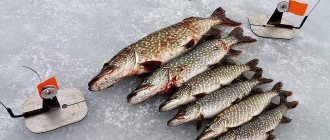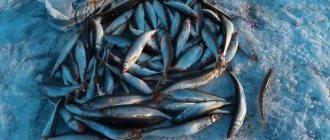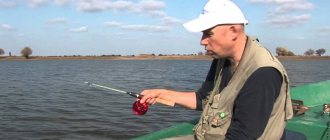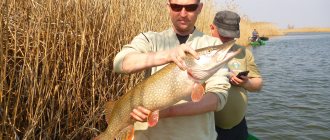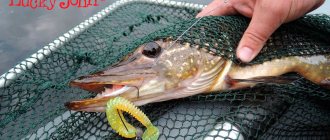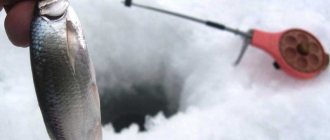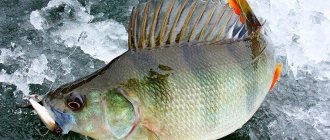For many pike fishermen, January is the most difficult “chapter” in their fishing life. A pike that has eaten its fill on the first ice becomes passive and extremely selective, as a result of which the number of bites not only on spoons and balancers, but also on jigs, is catastrophically reduced. But the fishermen are not discouraged and are trying to find their own way out of this situation. Everyone acts in their own way: some rely on an active search for fish - no, no, and you will “get under the nose” of the fish, which is determined to feed today. Others, on the contrary, adhere to a wait-and-see tactic and do not disturb the gear for a long time - what if the very same rig that you are going to move will work in about five minutes? Still others fish for pike exclusively with a headlamp - according to their observations, large pike feed at this time exclusively at night, and the small number of bites is more than compensated by the adrenaline received from landing trophy fish.
However, almost all of them miss the most important thing. Believing that live bait gear does not require any serious tricks, they deliberately doom themselves to failure. A thick, literally rope, fishing line, a rough leash, a heavy sinker and a large hook, as well as many other, less obvious elements, together do their job - the even rows of girders remain motionless for a long time. “It doesn’t bite...” - the fishermen lament, not realizing that they themselves are the real reason for the lack of bite!
Indicative for me was an incident that occurred in the middle of nowhere last year. We arrived at a typical pike reservoir in January, and even then there were rumors among the regulars about the extremely weak pike bite. But what can you do, hunting is worse than bondage - we’re exhibiting! It was not yet fully dawn on the street, but our fishermen were already expecting a bite, and we ourselves, taking jig tackle in our hands, tried to catch live bait.
Closer to 9 am, a local man appeared at the reservoir. He walked up to us with a leisurely gait and asked for an ice drill to drill holes in his heel. Before he had time to place the fifth bait, there was a bite on the first one, and after careful but precise fishing, the first “kiloshnitsa” ended up on the ice. We looked at each other - well, it happens...
Over the next 2 hours, the man received four bites and sold three of them. We stood there, watched him catch fish, and were perplexed: the girders were standing side by side, the live bait was almost identical, and the number of bites could not be compared!
In the end, fishermen's mutual assistance prevailed, and a man came up to us and inquired about the rigging of our girders. The first thing he said when he saw the montages was “No, guys, you won’t catch a pike like that...”. And he took one of his spare lanterns out of the box.
fishing line
“The local pike can be caught well all winter, but 2 weeks after the freeze-up it becomes very cautious. And to catch it, you have to think like a pike! " was the first thing the fisherman said by way of explanation. He began his story with a fishing line: a soft carp monofilament with a diameter of 0.25 mm was installed on his girders. “A little thin? You're kidding! Holds five kilos - do you often catch such pikes? — he answered our question with a question. According to him, a thick fishing line, in addition to extremely unimportant camouflage characteristics in clear water, almost always cakes and goes into the hole in rings, and in order to level it, you need a fairly heavy load, which also coarsens the equipment. As a result, the girder unmasks itself, and the fisherman loses control over the equipment while working with it. And all this for the sake of some mythical strength, which is not needed - during fishing, the fisherman’s fingers act as a friction clutch, and the hook in the final stage of fishing successfully replaces the landing net.
He also had a negative attitude towards fluorocarbon. “Yes, I tried flurry! Tough as a wire! — his conclusion was disappointing. But really, what’s the point of being unobtrusive when the tactile “flur” resembles a good wire and quite strongly hinders the movements of live bait on the tackle? In addition, everyone knows that fluorine is much weaker in tensile strength than classic fishing line, and therefore in order to achieve at least 5 kilograms of tensile strength, you have to use coarser, up to 0.4-0.45 millimeters in diameter, fluorocarbon!
Loading
Our gaze smoothly moved to the sinker. And here we saw a radically different vision of the problem. Instead of the classic, rather heavy olive, there were two miniature sliding pellets on the fishing line. The weight of the first, top, was three grams, while the second pellet, closest to the hook, weighed about one gram. Along with them, there were two classic silicone float stoppers on the line: one at the very swivel assembly, the second between the pellets. It would seem, why fence this garden?
The answer so far has been striking in its simplicity. If you understand the anatomy of the pike head, you will notice that the fish sees best around itself, as well as above itself. The predator will not see the prey below. But the predator doesn’t always lie in ambush at the very bottom! There are many factors that can cause it to rise upward - into the water column and even to the lower edge of the ice!
"Well. What are you doing? You lower the bait to the very bottom. And imagine - a pike is hanging in the water. Where will she see that bait fish?” . Indeed, it is so!
This is where a silicone stopper comes in handy! With its help, you can raise the sinker to half-water or even higher, thereby providing the live bait with complete freedom of action. Malek himself will choose the water horizon in which he will feel safe.
In addition, we should not forget that hydrogen sulfide, which is formed during the decay of algae, very often accumulates in the bottom layer. Live bait, rigidly fixed in the bottom layer, will fall asleep before the predator finds it. If you let the live bait “free swim”, it will certainly strive upward, choosing the most comfortable area in terms of oxygen conditions.
Why do you need a tiny second, bottom sinker? And in order to “keep” the live bait at least a little under control. If you release it into the hole without loading, you can be sure that within half an hour the fish will “hide” under the nearest bush or in the grass! The sinker at least slightly constrains his movements and does not allow him to “go wild”. In addition, with its help, it is much easier and faster to lower live bait to a given depth, especially when fishing occurs at a depth of 4 meters or more.
Leash
The local fisherman also criticized the leashes installed on our fishing rods. In his words, that condo-reliable approach to which we are all accustomed works only on the first ice, when the predator, roughly speaking, doesn’t care what it is. Things are completely different when it comes to fishing in the middle of nowhere. It is a thick and hard leash that can scare away the fish. Even if it does decide to grab, sensing something is wrong, the pike will rush to get rid of the bait. As a result, the bite does not continue, and after waiting, a battered live bait appears in the hole.
It is necessary to refine ourselves here too. In some cases, even thin and soft tungsten or Kevlar is not able to provide the required degree of camouflage. According to our interlocutor, the best results at this time are shown by either a classic fluorocarbon leader (as opposed to being used as a main line, fluor is an ideal solution as a leader material), or from a regular mono line with a diameter of 0.25 mm, made in the form of a twist.
Of course, such a delicate installation requires special handling. Classic, aggressive fishing in this situation almost always leads to the cutting of the leash - no matter how strong and rigid the leash is and no matter how tightly you intertwine the twist, they are not able to effectively resist pike teeth. It is for this reason that it is necessary to catch the fish at the maximum allowable slack, releasing the line at the slightest pull of the predator. A little trick also exists in the initial stage of fishing: after hooking, you should let the fish move 50-70 centimeters forward and then try to turn it around with a smoothly accelerated movement. In 70% of cases, the leash slips over the so-called “mustache”, as a result of which the probability of a sawed-off shotgun is reduced to almost zero.
The final stage of catching a predator also has its own characteristics. Throwing a pike that is not yet tired into a hole on a fishing line, as many anglers are used to doing, is a real disaster for a fishing line. At this moment, its tension tends to the maximum mark, which is why it is cut off once or twice. In order to cope with even a large pike, it is necessary to tire it even before the fish is brought to the hole, and only then use a hook or carefully take the fish with your hand under the gills or by the eye sockets, avoiding excessive tension of the fishing line and being in constant readiness to let her go for a walk.
The fisherman also dissuaded us from using traditional fasteners for attaching the tee. This is understandable - due to the fault of low-quality Chinese carabiners and fasteners that do not perform their function correctly, a huge number of failures occur in the final stage of fishing. There is a click, the clasp breaks or unbends, and the fish simply leaves with the hook in its mouth - this is not pleasant. It is for this reason that we did not see any classic swivels or carbines in its equipment. Instead, the leash had a miniature access ring with a threesome hanging from it. It is almost impossible to disable such a unit!
Catching pike with girders: how to choose hooks, leashes, lines, sinkers
No matter how many different fashion trends the fishing industry offers us, taking advantage of fishermen who are greedy for marketing tinsel, many old-fashioned fishing methods live firmly among our people. Among them is the zherlitsa: the tackle is inexpensive, creative and, most importantly, catchy.
Catching pike in winter on girders has been described many times in fishing literature and in Internet articles. Therefore, in order not to produce twin articles, I will describe only those developments to which my own eight-year experience of fishing with this gear led me. Yes, my experience is small, there is still a lot to be mastered, but I would like to share something now and, perhaps, hear pros and cons from my comrades in arms.
A separate article could be devoted to a description of the designs, nuances and details of the supply vent itself, so for now we’ll limit ourselves to a couple of comments. My firm belief: it’s not so important what’s on the ice, the main thing is what’s under the ice. In other words, the design of the girder is chosen according to your personal taste and color: either a store-bought one, or a homemade one, or a newfangled one without flags, or even the old-fashioned way - a twig and a piece of rag. It is only important that everything in it functions correctly. And one more thing: the vent must be quickly assembled and disassembled, have no small jewelry parts and a minimum of metal surfaces - all this creates additional problems in the cold.
About fishing lines
So, the girders were purchased or made independently, now they need to be equipped. First of all, the main fishing line. Everything is traditional here: diameter 0.35–0.4 mm. Thinner lines are, perhaps, rather weak, and may be not so much in relation to the powerful jerks of the fish, but rather to the possibility of rubbing against the edge of the ice or being damaged by the same scoop when clearing the hole from the ice crust. Well, thicker fishing lines are too stiff and springy. Of course, if fishing takes place in snags or near thick reeds, a holding potential is needed, and then the use of a thicker diameter main line naturally suggests itself. Hence the conclusion - balance the gear and fishing conditions.
The use of soft lines allows you to reduce the number of overlaps over the reel stand during a sharp release and inertial unwinding of the latter. My choice in this category is Sufix XL Srong 0.35 mm monofilament line. When loads are close to maximum, this line stretches greatly and thereby dampens the jerks of the fish.
About sinkers
The next part in the rig is the sinker. There are two nuances here: weight and mobility. The lighter the weight of the sinker, the less it alarms the predator, everything seems simple. It is only necessary to correlate the weight of the cargo with the fishing conditions. If it is a standing reservoir with fishing depths of 3–6 m, then 5–7 g will be quite enough. For fishing at 8–12 m, you will need 8–10 g. If fishing is supposed to be in shallow water up to 2 m, then you can use a small sinker weighing 3–4 g, or abandon it altogether and use a cut horned branch to drive live bait under thick ice.
When fishing in the current, of course, the load should be heavier. But again, in proportion to the fishing conditions. It is not very promising to look for pike in a powerful current; anyway, these will be places with almost stagnant water: bays, shallow ledges near holes, areas with reverse currents. And here a sinker weight of 14-18 g will be quite enough.
The second question is a sliding sinker or a blind one? With small weights there is no difference, but heavy weights (more than 10 g) should be sliding. You can compromise and put silicone stoppers above and below the sinker, and then by moving the stoppers you can make it either sliding or deaf. For example, a blind rig will be useful when fishing in mid-water at a sufficient depth, when after the trap is triggered, a heavy sliding sinker will drag the fishing line to the bottom, thereby forming a large loop that the angler will have to choose. Although this situation can be avoided by using the minimum possible weight of the sinker and carefully adjusted free play of the reel, when the latter does not unwind under the weight of the load.
About leashes
The next piece of equipment is the leash. A stumbling block that divided the zherlichniki into two camps. Some advocate the use of a metalized leash in order to avoid offensive cuts to the rig by the pike. Others prefer leashes made of monofilament fishing line, arguing their choice for low visibility, softness of the gear and an increase in the number of bites.
It’s difficult to advise anything here; everyone decides for themselves what they like best. My choice is the following - Hi-Seas fluorocarbon leader with a diameter of 0.45 mm (25Lb). This thickness allows you to bring out almost any pike without much effort, the main thing is not to force things. In previous seasons I used fluorocarbon with a diameter of 0.6 mm (40Lb). It is difficult to knit knots with such material, and the resulting knots look unpresentable in appearance.
However, with the help of crimping tubes, quite reliable loops for hooks and swivels are obtained. But we still had to abandon fluorocarbon of this diameter, having convinced ourselves that similar fishing line of a smaller thickness was sufficiently reliable. Although for those who doubt the reliability of fishing line equipment, it is quite suitable. So far, there have been no cuts with these leashes in four seasons of use, although pike weighing 5–8 kg have been caught. Monofilament fishing line with an equal diameter, in my opinion, is less resistant to damage from pike teeth than fluorocarbon. Again, it is less noticeable in water due to its refractive index being close to that of water.
To be fair, it should be noted that during my practice there were four leash cuts. But all these cases occurred during periods of experimentation with materials. Perhaps it makes sense to list these situations so that other fishermen do not find themselves in them out of ignorance.
- A double leash made of braided Dyneema cord 0.18 mm (this is the declared diameter, the real one is about 0.3 mm) - it was cut by a pike that felt like it weighed 4-5 kg. Everything is clear here: the fence is cut with pike teeth “with a bang.”
- Single HardMono leader from Climax 20lb 0.4 mm - cut by a pike weighing approximately 2.5 kg. Here I overly believed the manufacturer’s advertising exhortations and made unnecessary efforts to restrain the predator under the hole. In general, it’s my own fault! By the way, half an hour later, a 3-kilogram pike was calmly removed from a neighboring hole on exactly the same leash.
- Double HardMono leader from Cormoran 10lb ~ 0.3 mm - cut on hook. It's even difficult to comment.
- Single leash made of 0.5 mm monofilament line - burst under a hole on a pike up to 1.5 kg. The loops of the leader were made with crimp tubes, and, examining the location of the break, I came to the conclusion that the break occurred at the exit of the crimp tube. Apparently, the leash had broken, and the deformed fishing line in the tube could not withstand the load (in general, insignificant). This case served as another reason to abandon diameters of 0.5–0.6 mm in favor of 0.45 mm fishing line, which can be knitted without the use of crimping tubes.
It is quite possible that mono leashes are a thing of the past. Progress does not stand still, and the industry produces all kinds of leader materials - thin, soft and resistant to pike teeth.
An important factor is the softness of the leash. When the pike does not “touch” the presence of a foreign object, it swallows live bait more boldly. Using a double leash made of braided cord on two fishing trips brought me a pike weighing almost 3 kg and a cut of a larger pike. At that time, these were my largest trophies in lure fishing.
Of course, I refused braid for obvious reasons. However, the conclusion suggested itself: the transparency of the leash is not so important (rather, its inconspicuousness is needed) as its softness. These conditions are fully met by the leader material Cannelle Supraflex 7×7 with a breaking load of 6 kg. A thin and soft leash, indistinguishable from braided wire to the touch, and at the same time twisted from the finest metal wire. Among the minuses, one can note the frayability; nevertheless, the thin wire frays from contact with the teeth, and another minus is the high cost, the material is consumable, so the price is significant.
Another option is AFW Surflon 7×7 nylon coated leader material. In essence, the same Supraflex only in a shell, more similar to monofilament, although with a slightly larger diameter and more rigid to the touch.
The color of the fishing line does not seem to matter, but in my opinion it is better to use transparent fishing line. To straighten the line leash, immediately before setting it, pull it with force several times through the knee. This simple operation will also be an additional test of its strength.
A lot has already been said and written about fishing for pike on a leash from a fishing line, but I will briefly repeat the main points. The main condition is not to apply strong tension: the greater the force applied, the more easily the leash is damaged by the pike’s teeth. Accordingly, the load, for example up to 0.5 kg, will be the limit, exceeding which is fraught with the loss of the trophy.
All fishing happens at your fingertips, and your hands play the role of a clutch. With pikes weighing up to 2 kg, you don’t have to stand on ceremony, but you also don’t need to be overly zealous or in a hurry. Another very useful technique is to hook the leash by the mustache. The point is this: after a smooth hook, realizing that a fairly large pike has landed, we release a couple of meters of fishing line without loosening it. The fish moves away from the hole, and the fishing line, stretching along the predator’s body, ends up in the corner of the mouth. We smoothly stop the first jerk of the trophy and begin to pull it towards the hole, turning the pike’s head towards us.
During such manipulations, the leash in most cases gets behind the protrusion on the upper jaw, that is, behind the so-called “mustache”. As a result, during further fishing, the leash does not rub against the toothbrush. When using line leashes, this procedure is performed automatically at the first tug of the fish, so there is no need to rack your brains about how to do this correctly.
According to my personal feelings, a pike, taken by the “whisker,” makes fewer jerks, walks smoothly, pressing dully with its own weight. In contrast to the opposite situation, when the head is jerked from side to side along the line that is either weakening or tightening.
Well, when the pike is finally pressed to the hole, you should use the hook. Although, with some experience, by slightly releasing and pulling the trophy, you can ensure that the predator itself enters the hole. Such maneuvers work well with specimens up to 5 kg inclusive, with a standard hole of 130 mm. Speaking of the ice drill: I make do with the Barnaul Tonar-130 D, although, of course, a 150 mm hole is much more convenient for fishing and freezes less in severe frosts. The only negative is that drilling such holes is a little harder. On one or two drilled holes, the difference may not be noticeable, but on a couple of dozen it will already be noticeable.
About hooks
A few words about hooks. The main conditions are ideal sharpness and the smallest possible size. I have previously used VMC Spark Point No. 8 tees with a short forend. Now I have switched to the twins Cobra No. 4 and Cannelle No. 3 (according to the international classification). Not the most expensive and high quality, but at this stage these hooks suit me.
There was no deterioration in grip, but with tees in the dead of winter there were more idle bites. I can’t say anything about single hooks - I don’t have that kind of experience with pike. Although, perhaps this will be the next step in making the equipment more delicate.
Regarding delicate equipment, I would like to make one remark. There is a common belief among anglers that “When a pike takes, it takes anything!” This is a fundamentally wrong approach. Of course, this also happens, but it is extremely rare to get to the “distribution”, and you need to catch fish here and now, even if it is extremely picky and completely refuses to take it on traditional “reinforcement” girders. This is where miniature and delicate tackle comes to the rescue. This does not mean that all the pike will rush at it, but the likelihood that some predator will lose caution and be tempted by your tackle will increase significantly.
We often hear that delicate equipment (let’s call it installations made from fishing lines or the thinnest leader materials using miniature hooks) increases the number of lines in the catch, and if a large fish comes up, then it doesn’t care what kind of tackle. Quite a strange remark, because it turns out that a fish that has lived for many years and bypassed all the tricks of fishermen will suddenly lose its vigilance and covet a live bait hanging on a steel wire with a huge tee. On the contrary, an eternally hungry and thoughtless grasshopper will be extremely selective and picky about food items. To put it mildly, it's kind of absurd.
Tactics for searching for pike in a pond
It’s also difficult to add something new here, but we’ll try anyway. In my case, pike fishing takes place on small and shallow steppe saucer lakes, as well as in the oxbow lakes of the middle river and (to a lesser extent) directly in the middle river itself.
The first situation is an oxbow of a middle river with standing water and depths of up to 10–12 m. On the first ice, I choose the same places as for spinning fishing in late autumn. Usually this is more or less shallow watering with a pronounced drop into a riverbed or hole. For “my” reservoirs, I discovered the following trend: a large predator prefers to hunt on a relatively flat bottom with a gradual decline, but not far from steep slopes. That is, if you move along the edge, then the place where the edge becomes flat (the horizontal lines fan out) is the desired promising area (see figure).
A good guide for determining where to fish can be the breaks in the coastline: bays, capes, islands, narrowing or, conversely, widening.
The classic place is the bottom of the edge between the shallow area (bay, irrigation) and the riverbed. Also of great interest are all kinds of shallow water ledges: a spit or a cape with the obligatory presence of adjacent depths. The presence of forage fish at the fishing site is desirable, in other words: where the prey is kept, the predator grazes there. The entrances to various branches and branches are of considerable interest. Pike also like to hunt here. And, of course, it makes sense to check various shelters for an ambush - snags, reed islands.
On shallow saucer lakes, where there is no relief, the attachment is to aquatic vegetation. Usually this is a group of islands of rare reeds, even better if it is a chain of islands. The predator will most likely move along natural shelters, and, accordingly, placing traps between nearby islands increases the likelihood of getting on the trail.
An important role is played by the oxygen content in water, which by the end of winter is significantly reduced in stagnant reservoirs. In spring, high steep banks located on the sunny side thaw faster, and melt water falls under the ice, enriching the coastal area with oxygen. This also applies to ravines that open into a reservoir and carry melt water there.
It wouldn’t hurt to ask local fishermen about places with springs. Even if the information is doubtful, it is still not worth neglecting. And if you find yourself near such a place, you must check it for the presence of pike. In overseas reservoirs in February-March, baitfish exposed near the bottom begin to choke and stab.
Sometimes lifting the baitfish right under the ice helps, but it is much more promising to find the very area with springs where the baitfish will feel comfortable. Determining such an area is a fairly long-term matter: it can be identified either by setting up girders and observing the results, or by where white fish are caught, or technically, if there is a sensor for measuring dissolved oxygen.
Now let's talk about the depth of setting the live bait. Usually we set it traditionally from 0.5 to 1 m from the bottom. For the sake of experimentation, several live baits can be raised up to 2 m (this is at fishing depths of 4–6 m). But with normal oxygen conditions, I personally didn’t notice a big difference in the fishing horizon.
To speed up the process of setting the lures to the hook, using a regular stationery crocodile, I attach a weight weighing 40–50 g, which quickly and accurately delivers the hook to the bottom. Then I make three turns of the coil and set the depth. All that remains is to attach the bait and lower it into the hole.
The method of rigging live bait is also a hotly debated topic. It all depends, perhaps, on whether you are going to wait until the pike swallows the bait or whether you will hook without waiting for the reel to completely unwind (which happens quite rarely). I attach it under the dorsal fin, it is fast and reliable, and the gills (the most vital organ) are not injured in the live bait. In addition, you don’t waste time, you don’t freeze your hands in the canna with live bait while you’re baiting. But all of this is also not for everyone; whoever is more accustomed to what, I will not convince and prove the superiority of one over the other.
The second situation is an average river with a gentle current and background depths of 2–3 m and holes of 6–8 m, as well as whirlpools up to 20 m. All of the above can be applied to these conditions, adjusted for the current. For pike, places with reverse currents, exits from holes, bays on the border of currents, places with weak or reverse currents behind coastal ledges at the entrance to local holes will be attractive. Underwater spits are favorite hunting places for predators: the top of the head is usually occupied by pike, and the bottom and very tip of the spit is usually occupied by pike perch.
It is not worth looking for pike at great depths. In my opinion, the optimal depth for a large predator is 5-6 m with 2-3 m of ledges or shallows nearby. Below 10 m, I think there is no point in installing girders.
Large pike, having no natural enemies in the reservoir, are no longer so attached to aquatic vegetation. Therefore, she often prefers to stay near holes, that is, where bream concentrate in winter. The most promising area will be the exit from the pit in shallow water - a flat “table” in front of thickets of water lilies and reeds.
It has been noted that the lack of mass activity of small pike may be the result of the presence of a large individual in a given place. It’s another matter whether she will be tempted by your live bait or will show vigilance, thanks to which she lived to “deep gray hairs.”
Options for setting up the girders. Here you are on a pond and have chosen a promising site. How to arrange the girders? Firstly, you shouldn’t place them in a bunch; the spread between the outer holes can be quite impressive. The distance between neighboring girders should be at least 20-25 m. Usually I divide the fishing zone into 2-3 most promising areas, in which I place 3-4 girders.
We set up diagonally from the shallows to the depths. And if the bites began at a certain depth, then we carry out the subsequent rearrangement there. So, in one or two fishing trips, you can determine local catch points, at which we subsequently group some of the gear. We place the remaining vents in an unexplored area to discover new points. Often they are the ones who give the desired result.
How many girders should I display? Of course, in accordance with the standards - no more than 10 pieces. per person. The desire to “sow” the entire adjacent water area with your gear is not a manifestation of skill. It is better to place 3-4 vents in 2-3 promising places and then, in the absence of tans, engage in partial rearrangement.
Again, rearrangement is not an end in itself and should be carried out only as needed. Pike bite occurs through exits and therefore, if the place is proven, you should not get carried away with drastic changes. It’s better to wait for “hour X”! Well, what if the cherished exit never happened?.. Well, that means the appropriate adjustments will be made to the next fishing trip.
I usually fish with a partner, he catches live bait, and I do the fishing, so I can afford to put up to twenty tackles. But in practice I never put more than twelve pieces, a maximum of four vents in three different areas. When fishing alone, I make do with 10 rods.
In terms of fishing time, general patterns are also difficult to trace; they are different for each reservoir and change during the freeze-up period. In some cases, the bite occurs from dawn until 10 o'clock, and then falls silent until the evening. In other situations, exits are observed in the pre-lunch time, around 11–12 o’clock. In any case, the earlier you set out, the greater the chance of capturing the morning bite, which rarely happens. Let me note that I don’t fish for several days in a row with overnight stays and leaving the fishing poles overnight. My fishing is weekend fishing, and it usually lasts from dawn to 14-15 hours, during which time the catch is usually made, positive emotions are received, or everything is so sad that further waiting for the ephemeral evening bite is boring and futile.
In conclusion, I would like to return once again to live bait. The ability to set up the zherlits as early as possible is sometimes crucial. There are periods when pike bite only at dawn, and then anyone who didn’t have time is late. Therefore, a pre-prepared supply of live bait is needed. If there is an opportunity to catch live bait in a pike fishing area, then from each fishing trip I bring home a supply of 1.5–2 dozen fish. I store them on the loggia in a 20 liter plastic basin. The basin is wrapped in an old sleeping bag so that the water does not freeze in severe frosts.
When winter is particularly fierce, I take the basin home at night. The first year I managed without an aquarium compressor, I simply replaced 5 liters of water every day with fresh water (settled, but at room temperature). Now I have purchased an aerator, which allows me to do without daily water changes. However, for new live baits, after 2-3 days, when they empty their intestines, it is necessary to change all the water. The main thing is to avoid sudden temperature changes and if the water suddenly becomes cloudy, be sure to change it. Live baits generally live all winter. There is no need to feed them. If it is not possible to catch fresh live bait, you can bring used ones (“split”) back. Particularly persistent ones survive up to 3-4 fishing trips. In the absence of suitable live bait, you can even use dead bait, but it must be fresh.
Species preferences for live bait may largely depend on the food supply of the intended target. In any case, I would prefer to use roach as live bait. On lakes, there are often simply no other fish besides perch and pike, and there is no choice. In my humble opinion, all other things being equal, roach is preferable, although I caught my largest bait trophy on perch.
Also interesting as live bait are small crucian carp (very tenacious, especially in overseas reservoirs: where roach are suffocating, crucian carp can help out), large minnow (not often used in winter, but pike like it), dace (quite tenacious and very mobile). About perch, we can say that it is an extremely active baitfish, it often knocks out the flag itself and another feature is its tendency to the bottom. If the roach walks in circles, trying to rise higher, then the perch, on the contrary, tends to go down. I don’t remember ever catching anything with a ruff, but I have found “admirals” in the belly of a large pike, so why not live bait, for lack of anything better?
And the last thing: if you are lucky enough to get what is called a “distribution”, do not be a grabber: three or four medium-sized pike is already quite a sufficient catch. There is no point in building up woodpiles and filling bags. Unless, of course, you plan to go winter fishing with girders more than once.
Hook
“There is no clear solution here. It all depends on what goals you set for yourself and how you hook the bait.” With these words, a miniature box with ready-made leashes for fishing appeared in the fisherman’s hands. “The pike, such an infection, cuts the leash only at moments of greatest tension, when you pull it forcefully. Or in the final stage of fishing - this can no longer be avoided! It is for this reason that I prefer to change the leader after each pike. I put them in a box and check them at home. The slightest qualms - get out!” More than a reasonable and logical explanation!
The fisherman's arsenal included two types of hooks. For classic pike fishing, our interlocutor almost always used small, miniature tees made of fairly thin wire. This condition is very important: it is the thin hook that least of all injures the live bait and does not hinder its movements in the water. The tips of the hooks are bent inward, which significantly reduces the risk that the predator will “prick itself” when it transfers live bait into its mouth.
When the predator is “on strike” or the fishing takes place at night, miniature twins are used. On leashes intended for use with doubles, there are no winding rings: the hook is wound directly onto the leash itself. This is done due to the specifics of baiting bait: the only effective method for such fishing is to pass the leash through the gill cover and remove it through the bait’s mouth. A deft movement of the hand - and a double takes its place at the end of the leash, which a moment later ends up in the baitfish’s mouth. A similar method is also used when fishing for pike perch - this is how you can achieve maximum results from pike perch bites.
Which hooks are better
To catch pike, different types of hooks and different techniques for installing them are used. They are selected depending on the time of year, the depth of the reservoir, the gear used and the fishing method. The most important requirement for a hook is its sharpness, since the pike’s mouth is hard and quite toothy, and it can be difficult to hook it securely.
For spinning fishing
The most popular baits for spinning fishing: wobblers, spoons and silicone baits. For each bait, appropriate hooks are selected.
- For oscillating and rotating spinners, single, double and triple hooks are used. Sometimes a hook with 4 or even more hooks is used.
- Wobblers are rarely equipped with double hooks; triple or single hooks are often used.
- Silicone baits are equipped with an offset, double or triple hook.
For fishing with silicone, it is better to purchase special offset hooks. They can be of various shapes. When choosing, you also need to focus on the size, shape of the bait and the expected weight of the trophy. If the bait is narrow-bodied and elongated, hooks with a straight shank are suitable. However, the most popular models are those with a wide curve on the fore-end - it is this shape that allows you to reliably hook the fish, thereby reducing the number of empty bites.
For zherlitsy
For girder fishing, all types of hooks are used, both single and double and tees:
- Single ones are used when the size of live bait is no more than 5 cm, but this method increases the number of times the predator leaves the hook.
- Double hooks are used for “lazy” rigging, when its forends are threaded through the gills of the baitfish, and the predator swallows it without noticing the hook. Therefore, the number of empty bites or abandoned live baits is much less.
Tees are often used for vents. They guarantee the maximum percentage of successful hooking and bringing the prey onto the ice.
About live bait
“What is the best way to fish? Yes, what she eats!” — the fisherman answered our question about live bait and confirmed the most traditional opinion about the best live bait for catching pike. What could be simpler and more logical - to fish for what is the main food of the predator. However, there are some peculiarities here: when there are more than a dozen fish in the reservoir that can become potential food, choosing live bait is not so easy!
“In my opinion, the best live bait is roach. It is found almost everywhere, and pike are very familiar with it. Perch is also not bad, especially on any peat bogs. But the minnow on the pike is nothing at all, no matter how many times we tried to put it on the pike - no progress! Well, crucian carp - you have to use it out of desperation, when there is no other option for live bait and it is not possible to catch it.”
According to our observations, this is approximately the case: the gudgeon is as good at catching pike-perch and large perch, as it is bad at catching pike in still waters. No matter how many of my colleagues tried to catch a pike with it, such fishing almost always ended in failure. And at the same time, nearby roach and crucian carp were in high demand among pikes: rods loaded with them were fired with enviable regularity.
We never managed to catch a pike on that fishing trip. However, we took the advice we heard from the local pikeman very seriously and re-equipped our girders in the same way as we learned from him. Already on the next fishing trip we were able to verify the veracity of his words: before we had time to set our rigs to the end, a malfunction occurred on the first one, and the first one and a half rod ended up on the ice. Pike loves delicate montages, how much he loves them!
How to catch pike in winter using girders
Catching pike with girders in winter, with girders placed on the pond
In order to ensure a good catch, you first need to choose the right place for fishing. Ideally, it would be to discover the habitat of the pike. Having found a fish outlet, in one day you can catch up to 5-7 individuals of these predators and, perhaps, a large pike will be among them. This is normal for a nerd. If desired, you can also fish at night.
Where to place the girders?
In winter, pike are mainly found in the pond in ambush. From the same place she constantly watches the fish swimming nearby. As soon as the prey approaches the required distance, the predator suddenly attacks it.
It is necessary to make winter supplies and install girders in certain places depending on the type of reservoir:
- On the rivers . In this case, it is better to choose deep bays, holes under rifts, small pools, or plants above capes.
- On ponds and lakes . In such a situation, you need to navigate along the boundaries of vegetation. You can also choose places in the channels between the island and the shore. You need to pay attention to snags, cliffs and bushes.
To examine the bottom of a reservoir, it is best to use an echo sounder. If the reservoir will be visited for fishing in the future, you can use a jig or a spinner instead. In the process of examining the bottom, it is important to note for yourself various changes in depth or the presence of any obstacles. It would not be superfluous to analyze the behavior of local fishermen, since they must know exactly all the features of a particular reservoir.
How to properly place girders on pike in winter?
Good, interesting and effective fishing can be ensured by correctly stopping the girder. To do this, you need to adhere to the following tips:
- it is worth choosing steep banks;
- the current at the site where the hole is created should be slow and calm;
- the distance to the shore should not exceed 20 meters.
The distances between the girders should be such that the fisherman can move without any difficulties, in time for a bite. The bait installation technique should take place directly on the reservoir - after holes have been drilled in the ice.
When does pike bite on girders in winter?
In order for fishing to be as successful as possible, it is very important to understand when exactly in the winter the pike bites on the girders. In this regard, there are the following behavioral features of this predatory fish that need to be taken into account:
Thus, by fishing in accordance with the above tips, you can secure a significant winter catch of pike.
Cloudflare Ray ID: 63a8ad3b4f19169d • Your IP: 195.64.208.251 • Performance & security by Cloudflare
Regardless of the type, all designs are equipped the same. An olive-shaped sinker is put on a monofilament line with a diameter of 0.25 to 0.5 mm, a stopper is placed under it, and then a leash with a regular hook, double or tee is attached. The thickness of the main line is selected taking into account the average size of the predator in the pond. The weight of the load must correspond to the strength of the current and hold the live fish on the point.
